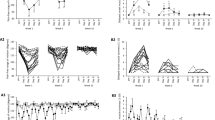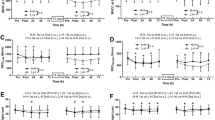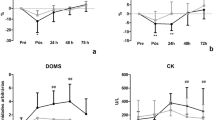Abstract
Purpose
This study assessed markers of muscle damage and training adaptations to eccentric-overload flywheel resistance exercise (RE) in men and women.
Methods
Dynamic strength (1 RM), jump performance, maximal power at different percentages of 1 RM, and muscle mass in three different portions of the thigh were assessed in 16 men and 16 women before and after 6 weeks (15 sessions) of flywheel supine squat RE training. Plasma creatine kinase (CK) and lactate dehydrogenase (LDH) concentrations were measured before, 24, 48 and 72 h after the first and the last training session.
Results
After training, increases in 1 RM were somewhat greater (interaction P < 0.001) in men (25 %) than in women (20 %). Squat and drop jump height and power performance at 50, 60, 70 and 80 % of 1 RM increased after training in both sexes (P < 0.05). Power improvement at 80 % of 1 RM was greater (interaction P < 0.02) in men than women. Muscle mass increased ~5 % in both groups (P < 0.05). CK increased in men after the first training session (P < 0.001), whereas the response in women was unaltered. In both sexes, LDH concentration was greater after the first training session compared with basal values (P < 0.05). After the last session, CK and LDH remained at baseline in both groups.
Conclusions
These results suggest that although improvements in maximal strength and power at high loads may be slightly greater for men, eccentric-overload RE training induces comparable and favorable gains in strength, power, and muscle mass in both men and women. Equally important, it appears muscle damage does not interfere with the adaptations triggered by this training paradigm.





Similar content being viewed by others

Abbreviations
- ANOVA:
-
Analysis of variance
- CK:
-
Creatine kinase
- CMJ:
-
Countermovement jump
- CON:
-
Concentric
- DJ:
-
Drop jump
- DXA:
-
Dual energy X-ray absorptiometry
- ECC:
-
Eccentric
- LDH:
-
Lactate dehydrogenase
- MRI:
-
Magnetic resonance imaging
- RE:
-
Resistance exercise
- RM:
-
Repetition maximum
- SEM:
-
Standard error of the mean
- SJ:
-
Squat jump
References
Abe T, DeHoyos DV, Pollock ML, Garzarella L (2000) Time course for strength and muscle thickness changes following upper and lower body resistance training in men and women. Eur J Appl Physiol 81(3):174–180. doi:10.1007/s004210050027
Alkner BA, Tesch PA (2004a) Efficacy of a gravity-independent resistance exercise device as a countermeasure to muscle atrophy during 29-day bed rest. Acta Physiol Scand 181(3):345–357. doi:10.1111/j.1365-201X.2004.01293.x
Alkner BA, Tesch PA (2004b) Knee extensor and plantar flexor muscle size and function following 90 days of bed rest with or without resistance exercise. Eur J Appl Physiol 93(3):294–305. doi:10.1007/s00421-004-1172-8
Allen DG (2001) Eccentric muscle damage: mechanisms of early reduction of force. Acta Physiol Scand 171(3):311–319. doi:10.1046/j.1365-201x.2001.00833.x
Andreoli A, Scalzo G, Masala S, Tarantino U, Guglielmi G (2009) Body composition assessment by dual-energy X-ray absorptiometry (DXA). Radiol Med 114(2):286–300. doi:10.1007/s11547-009-0369-7
Askling C, Karlsson J, Thorstensson A (2003) Hamstring injury occurrence in elite soccer players after preseason strength training with eccentric overload. Scand J Med Sci Sports 13(4):244–250
Barroso R, Roschel H, Ugrinowitsch C, Araujo R, Nosaka K, Tricoli V (2010) Effect of eccentric contraction velocity on muscle damage in repeated bouts of elbow flexor exercise. Appl Physiol Nutr Metab 35(4):534–540. doi:10.1139/H10-042
Berg HE, Tesch A (1994) A gravity-independent ergometer to be used for resistance training in space. Aviat Space Environ Med 65(8):752–756
Billaut F, Smith K (2009) Sex alters impact of repeated bouts of sprint exercise on neuromuscular activity in trained athletes. Appl Physiol Nutr Metab 34(4):689–699. doi:10.1139/H09-058
Cannon JG, Meydani SN, Fielding RA, Fiatarone MA, Meydani M, Farhangmehr M, Orencole SF, Blumberg JB, Evans WJ (1991) Acute phase response in exercise. II. Associations between vitamin E, cytokines, and muscle proteolysis. Am J Physiol 260(6 Pt 2):1235–1240
Chen TC, Chen HL, Lin MJ, Wu CJ, Nosaka K (2009) Muscle damage responses of the elbow flexors to four maximal eccentric exercise bouts performed every 4 weeks. Eur J Appl Physiol 106(2):267–275. doi:10.1007/s00421-009-1016-7
Colliander EB, Tesch PA (1990) Effects of eccentric and concentric muscle actions in resistance training. Acta Physiol Scand 140(1):31–39
Colliander EB, Tesch PA (1991) Responses to eccentric and concentric resistance training in females and males. Acta Physiol Scand 141(2):149–156
Colliander EB, Tesch PA (1992) Effects of detraining following short term resistance training on eccentric and concentric muscle strength. Acta Physiol Scand 144(1):23–29
Delmonico MJ, Kostek MC, Doldo NA, Hand BD, Bailey JA, Rabon-Stith KM, Conway JM, Carignan CR, Lang J, Hurley BF (2005) Effects of moderate-velocity strength training on peak muscle power and movement velocity: do women respond differently than men? J Appl Physiol 99(5):1712–1718. doi:10.1152/japplphysiol.01204.2004
Dudley GA, Tesch PA, Harris RT, Golden CL, Buchanan P (1991a) Influence of eccentric actions on the metabolic cost of resistance exercise. Aviat Space Environ Med 62(7):678–682
Dudley GA, Tesch PA, Miller BJ, Buchanan P (1991b) Importance of eccentric actions in performance adaptations to resistance training. Aviat Space Environ Med 62(6):543–550
Esbjornsson M, Rundqvist HC, Mascher H, Osterlund T, Rooyackers O, Blomstrand E, Jansson E (2012) Sprint exercise enhances skeletal muscle p70S6 k phosphorylation and more so in women than in men. Acta Physiol (Oxf) 205(3):411–422. doi:10.1111/j.1748-1716.2012.02404.x
Fernandez-Gonzalo R, De Paz JA, Rodriguez-Miguelez P, Cuevas MJ, Gonzalez-Gallego J (2012) Effects of eccentric exercise on toll-like receptor 4 signaling pathway in peripheral blood mononuclear cells. J Appl Physiol 112(12):2011–2018. doi:10.1152/japplphysiol.01499.2011
Garcia-Lopez D, Cuevas MJ, Almar M, Lima E, De Paz JA, Gonzalez-Gallego J (2007) Effects of eccentric exercise on NF-kappaB activation in blood mononuclear cells. Med Sci Sports Exerc 39(4):653–664. doi:10.1249/mss.0b013e31802f04f6
Golden CL, Dudley GA (1992) Strength after bouts of eccentric or concentric actions. Med Sci Sports Exerc 24(8):926–933
Hansen RD, Williamson DA, Finnegan TP, Lloyd BD, Grady JN, Diamond TH, Smith EUR, Stavrinos TM, Thompson MW, Gwinn TH (2007) Estimation of thigh muscle cross-sectional area by dual-energy X-ray absorptiometry in frail elderly patients. Am J Clin Nutr 86(4):952
Hather BM, Tesch PA, Buchanan P, Dudley GA (1991) Influence of eccentric actions on skeletal muscle adaptations to resistance training. Acta Physiol Scand 143(2):177–185
Hubal MJ, Gordish-Dressman H, Thompson PD, Price TB, Hoffman EP, Angelopoulos TJ, Gordon PM, Moyna NM, Pescatello LS, Visich PS, Zoeller RF, Seip RL, Clarkson PM (2005) Variability in muscle size and strength gain after unilateral resistance training. Med Sci Sports Exerc 37(6):964–972
Kraemer WJ, Staron RS, Hagerman FC, Hikida RS, Fry AC, Gordon SE, Nindl BC, Gothshalk LA, Volek JS, Marx JO, Newton RU, Hakkinen K (1998) The effects of short-term resistance training on endocrine function in men and women. Eur J Appl Physiol Occup Physiol 78(1):69–76
Krentz JR, Farthing JP (2010) Neural and morphological changes in response to a 20-day intense eccentric training protocol. Eur J Appl Physiol 110(2):333–340. doi:10.1007/s00421-010-1513-8
Lundberg TR, Fernandez-Gonzalo R, Gustafsson T, Tesch PA (2013) Aerobic exercise does not compromise muscle hypertrophy response to short-term resistance training. J Appl Physiol 114(1):81–89. doi:10.1152/japplphysiol.01013.2012
Mastaloudis A, Traber MG, Carstensen K, Widrick JJ (2006) Antioxidants did not prevent muscle damage in response to an ultramarathon run. Med Sci Sports Exerc 38(1):72–80. doi:00005768-200601000-00012
Melnyk JA, Rogers MA, Hurley BF (2009) Effects of strength training and detraining on regional muscle in young and older men and women. Eur J Appl Physiol 105(6):929–938. doi:10.1007/s00421-008-0979-0
Milias GA, Nomikos T, Fragopoulou E, Athanasopoulos S, Antonopoulou S (2005) Effects of eccentric exercise-induced muscle injury on blood levels of platelet activating factor (PAF) and other inflammatory markers. Eur J Appl Physiol 95(5–6):504–513. doi:10.1007/s00421-005-0031-6
Miller AE, MacDougall JD, Tarnopolsky MA, Sale DG (1993) Gender differences in strength and muscle fiber characteristics. Eur J Appl Physiol Occup Physiol 66(3):254–262
Neme Ide B, Alessandro Soares Nunes L, Brenzikofer R, Macedo DV (2013) Time course of muscle damage and inflammatory responses to resistance training with eccentric overload in trained individuals. Mediat Inflamm 2013:204942. doi:10.1155/2013/204942
Norrbrand L, Fluckey JD, Pozzo M, Tesch PA (2008) Resistance training using eccentric overload induces early adaptations in skeletal muscle size. Eur J Appl Physiol 102(3):271–281. doi:10.1007/s00421-007-0583-8
Norrbrand L, Pozzo M, Tesch PA (2010) Flywheel resistance training calls for greater eccentric muscle activation than weight training. Eur J Appl Physiol 110(5):997–1005. doi:10.1007/s00421-010-1575-7
Norrbrand L, Tous-Fajardo J, Vargas R, Tesch PA (2011) Quadriceps muscle use in the flywheel and barbell squat. Aviat Space Environ Med 82(1):13–19
Nosaka K, Newton M (2002) Concentric or eccentric training effect on eccentric exercise-induced muscle damage. Med Sci Sports Exerc 34(1):63–69
O’Hagan FT, Sale DG, MacDougall JD, Garner SH (1995) Response to resistance training in young women and men. Int J Sports Med 16(5):314–321. doi:10.1055/s-2007-973012
Petrella JK, Kim JS, Tuggle SC, Bamman MM (2007) Contributions of force and velocity to improved power with progressive resistance training in young and older adults. Eur J Appl Physiol 99(4):343–351. doi:10.1007/s00421-006-0353-z
Ploutz-Snyder LL, Giamis EL, Formikell M, Rosenbaum AE (2001) Resistance training reduces susceptibility to eccentric exercise-induced muscle dysfunction in older women. J Gerontol A Biol Sci Med Sci 56(9):384–390
Rittweger J, Felsenberg D, Maganaris C, Ferretti JL (2007) Vertical jump performance after 90 days bed rest with and without flywheel resistive exercise, including a 180 days follow-up. Eur J Appl Physiol 100(4):427–436. doi:10.1007/s00421-007-0443-6
Romero-Rodriguez D, Gual G, Tesch PA (2011) Efficacy of an inertial resistance training paradigm in the treatment of patellar tendinopathy in athletes: a case-series study. Phys Ther Sport 12(1):43–48. doi:10.1016/j.ptsp.2010.10.003
Schroeder ET, Hawkins SA, Jaque SV (2004) Musculoskeletal adaptations to 16 weeks of eccentric progressive resistance training in young women. J Strength Cond Res 18(2):227–235. doi:10.1519/r-13443.1
Shephard RJ (2000) Exercise and training in women, part I: influence of gender on exercise and training responses. Can J Appl Physiol 25(1):19–34
Staron RS, Karapondo DL, Kraemer WJ, Fry AC, Gordon SE, Falkel JE, Hagerman FC, Hikida RS (1994) Skeletal muscle adaptations during early phase of heavy-resistance training in men and women. J Appl Physiol 76(3):1247–1255
Stupka N, Lowther S, Chorneyko K, Bourgeois JM, Hogben C, Tarnopolsky MA (2000) Gender differences in muscle inflammation after eccentric exercise. J Appl Physiol 89(6):2325–2332
Stupka N, Tarnopolsky MA, Yardley NJ, Phillips SM (2001) Cellular adaptation to repeated eccentric exercise-induced muscle damage. J Appl Physiol 91(4):1669–1678
Tesch PA, Ekberg A, Lindquist DM, Trieschmann JT (2004) Muscle hypertrophy following 5-week resistance training using a non-gravity-dependent exercise system. Acta Physiol Scand 180(1):89–98
Thompson HS, Scordilis SP (1994) Ubiquitin changes in human biceps muscle following exercise-induced damage. Biochem Biophys Res Commun 204(3):1193–1198. doi:10.1006/bbrc.1994.2589
Tiidus PM (2000) Estrogen and gender effects on muscle damage, inflammation, and oxidative stress. Can J Appl Physiol 25(4):274–287
Trappe TA, Burd NA, Louis ES, Lee GA, Trappe SW (2007) Influence of concurrent exercise or nutrition countermeasures on thigh and calf muscle size and function during 60 days of bed rest in women. Acta Physiol (Oxf) 191(2):147–159. doi:10.1111/j.1748-1716.2007.01728.x
Velders M, Diel P (2013) How sex hormones promote skeletal muscle regeneration. Sports Med 43(11):1089–1100. doi:10.1007/s40279-013-0081-6
Acknowledgments
This study was partly funded by Consejería de Educación, Junta de Castilla y León, Spain.
Conflict of interest
The authors declare no conflicts of interest.
Author information
Authors and Affiliations
Corresponding author
Additional information
Communicated by Peter Krustrup.
Rights and permissions
About this article
Cite this article
Fernandez-Gonzalo, R., Lundberg, T.R., Alvarez-Alvarez, L. et al. Muscle damage responses and adaptations to eccentric-overload resistance exercise in men and women. Eur J Appl Physiol 114, 1075–1084 (2014). https://doi.org/10.1007/s00421-014-2836-7
Received:
Accepted:
Published:
Issue Date:
DOI: https://doi.org/10.1007/s00421-014-2836-7



